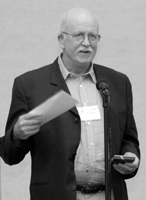Emphasis on Excellence: 2004 SIAM Prizes
September 26, 2004

On July 13, with a talk titled "Natural Patterns," Alan C. Newell of the University of Arizona and the University of Warwick joined the distinguished list of SIAM's John von Neumann lecturers. Shown here at the prize luncheon with SIAM president Mac Hyman, Newell was chosen to give the 2004 lecture "in recognition of his pioneering research in nonlinear evolution equations modeling physical systems. His deep analysis and his creative insight into nonlinear waves and patterns have given us new ways to analyze and understand the creation and dynamical behavior of patterns and coherent structures. He has made seminal contributions to the analysis of integrable partial differential equations and turbulence and provided leadership in identifying new approaches to understanding the creation and dynamical behavior of solitons and patterns in optical and fluid systems." In addition to shaping research areas, Newell has "built academic programs of international prominence, and promoted the growth of young scientists through his influence as mentor and teacher." The award, the citation concludes, "recognizes all of his profound contributions to modern applied mathematics."
Honored on July 15 at the prizes and awards luncheon during the 2004 SIAM Annual Meeting in Portland, Oregon, were the following prize recipients:
- I.E. Block Community Lecture: Michael B. Ray, ExxonMobile Upstream Research Co.
- Richard C. DiPrima Prize: Diego Dominici, University of Illinois, Chicago; (now at the State University of New York, New Paltz)
- AWM-SIAM Sonia Kovalevsky Lecture: Joyce R. McLaughlin, Rensselaer Polytechnic Institute
- Outstanding Paper Prizes: G�rard Cornu�jols, Carnegie Mellon University; Bertrand Guenin, University of Waterloo; Feimin Huang, Academia Sinica; Zhen Wang, City University of Hong Kong; Alfio Quarteroni, Politecnico di Milano; Alessandro Veneziani, Ecole Polytechnique F�d�rale de Lausanne and Politecnico di Milano; Paolo Zunino, Ecole Polytechnique F�d�rale de Lausanne
- George P�lya Prize: Neil Robertson, Ohio State University, and Paul Seymour, Princeton University
- W. T. and Idalia Reid Prize: Arthur J. Krener, University of California, Davis
- SIAM Award in the Mathematical Contest in Modeling:
Problem A: Steven Avery, Eric Harley, and Eric Malm, Harvey Mudd College; adviser, Jon T. Jacobsen
Problem B: Moorea Brega, Alejandro Cantarero, and Corry Lee, University of Colorado, Boulder; adviser, Bengt Fornberg - SIAM Prize for Distinguished Service to the Profession: Richard A. Tapia, Rice University
- SIAM Student Paper Prizes: Silas D. Alben, Courant Institute, New York University; Alfonso Bueno Orovio, University of Castilla-La Mancha; Martin Kleinsteuber, University of W�rzburg
- Theodore von K�rm�n Prize: Roland Glowinski, University of Houston
- The John von Neumann Lecture: Alan C. Newell, University of Arizona

"For fundamental contributions to control and estimation of nonlinear dynamical systems and stochastic processes," Arthur J. Krener of the University of California, Davis, was named the 2004 recipient of the W.T. and Idalia Reid Prize. The prize, now awarded annually, was established in 1993 to recognize outstanding work in differential equations or control theory, areas in which W.T. Reid worked. Krener, who thanked the Reid family (Idalia Reid, who died in 2000, endowed the prize in memory of her husband, W.T.), gave the prize lecture, "Control Bifurcations: How a Nice Control System Can Go Bad," on July 12.

For "a well-presented thesis on fluid queueing models that shows a mature mastery of the subject area and establishes novel asymptotic analyses of important practical situations using the ray method of geometric optics," Diego Dominici (left), now an assistant professor of mathematics at the State University of New York at New Paltz, received the 2004 Richard C. DiPrima Prize. The biannual prize recognizes young scientists for outstanding research in applied mathematics. Dominici's thesis, written at the University of Illinois at Chicago, shows "applied mathematics at its best," the prize committee wrote, citing its "carefully derived and described models and powerful analysis that gives much insight and great application potential in such important practical areas as communication networks."

